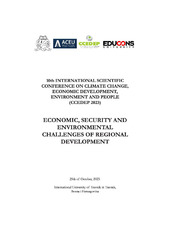Prikaz osnovnih podataka o dokumentu
Eco-innovations in the Creation of New Capacities for Achieving the Goals of the Green Economy - Case of the Midas Project
| dc.creator | Marjanović Jeromela, Ana | |
| dc.creator | Andrejević Panić, Andrea | |
| dc.creator | Vukadinović, Simonida | |
| dc.creator | Ješić, Jelena | |
| dc.creator | Alexopoulou, Efi | |
| dc.date.accessioned | 2024-02-27T11:46:29Z | |
| dc.date.available | 2024-02-27T11:46:29Z | |
| dc.date.issued | 2023 | |
| dc.identifier.isbn | 978-86-82088-14-1 | |
| dc.identifier.uri | https://redun.educons.edu.rs/handle/123456789/634 | |
| dc.description.abstract | Institute for Agriculture and Vegetables, National Institute of im- portance for the Republic of Serbia, in consortium of 25 partners from 13 European countries engage all relevant stakeholders (agricultural community, bio-based industry, academic community, etc.) in dissemination and exploita- tion of project results and encouragement of international cooperation to exchange best practices and create scenarios for the benefit of all in develop- ment of business plans to encourage circularity at the farm level through en- gagement agricultural community, industrial actors and academic community through project case studies. In this context the MIDAS - Marginal lands, industrial crops and in- novative bio-based value chains project, which has been funded by the Hori- zon Europe framework program, decided to address challenges contained in specific goals of the MIDAS: Increasing knowledge about current and future marginal land for “low ILUC” biomass production, challenges biodiversity and ecosystem services, as well as potential common ones benefits from bio- mass production. “Low-ILUC” (ILUC - Indirect Land Use Change) is a fac- tor that indicates in to what extent is there a risk of changing the use of arableland for the production of raw materials for products that they are not food. Raw materials that have a low ILUC risk were created by growing industrial crops on marginal land or by cultivating areas that were not used for plant production or were abandoned, through the improvement of agricultural practices, which keeps the areas for the production of food raw materials at the same level. Optimization of the production of selected industrial plant species, adapted to cultivation on marginal agricultural land in the 9th state, in 12 localities to achieve a low level of ILUC. Establishment of case studies (12 in 9 countries) of innovative systems cultivation (combined sowing and agroforestry) which have a low ILUC level at marginal agricultural land at the agricultural level farms, for current and future systems in agriculture. Utilization of marginal lands for growing sustainable industrial crops and developing innovative bio-based products represents significant eco-in- novation that contributes to increasing the number and quality of the impacts on the green economy network of excellent case studies: Development of 13 new bio products (biobased) in accordance with circular use biomass. Devel- opment of innovative value chains/networks based on biologically effective resources and assessment of production sustainability, including impacts on biodiversity. | sr |
| dc.language.iso | en | sr |
| dc.publisher | Sremska Kamenica : Educons University | sr |
| dc.relation | info:eu-repo/grantAgreement/EC/HE/101082070/EU// | sr |
| dc.relation | info:eu-repo/grantAgreement/ScienceFundRS/Identiteti/303/RS// | sr |
| dc.rights | openAccess | sr |
| dc.rights.uri | https://creativecommons.org/licenses/by/4.0/ | |
| dc.source | Scientific Conference on Climate Change, Economic Development, Environment and People, Proceedings of 10th International Scientific Conference on Climate Change, Economic Development, Environment and People (CCEDEP 2023), October 25, Travnik, Bosnia and Herzegovina | sr |
| dc.subject | Green Economy | sr |
| dc.subject | Eco-innovations | sr |
| dc.subject | Sustainable development | sr |
| dc.subject | Biodiversity | sr |
| dc.title | Eco-innovations in the Creation of New Capacities for Achieving the Goals of the Green Economy - Case of the Midas Project | sr |
| dc.type | conferenceObject | sr |
| dc.rights.license | BY | sr |
| dc.citation.epage | 138 | |
| dc.citation.spage | 129 | |
| dc.identifier.fulltext | http://redun.educons.edu.rs/bitstream/id/1474/bitstream_1474.pdf | |
| dc.type.version | publishedVersion | sr |

